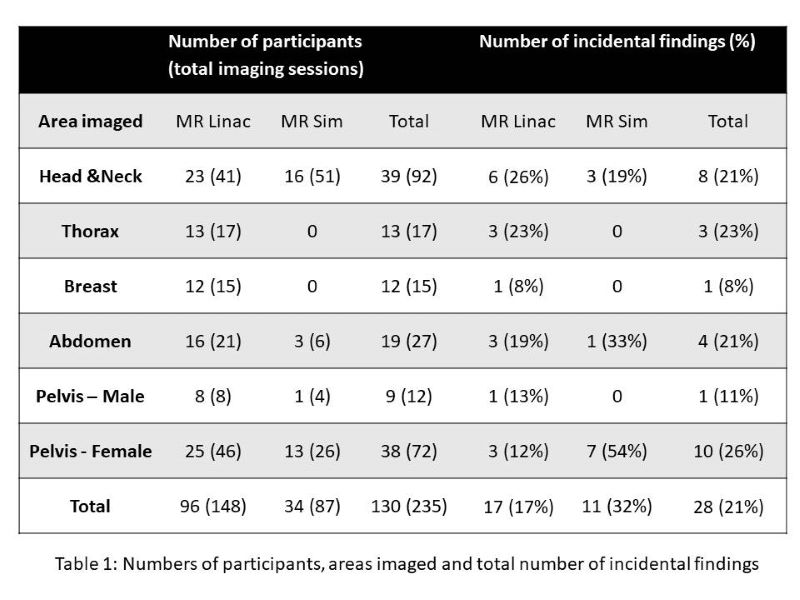Incidental findings in non-patient, volunteer MR imaging: a single centre experience
Lisa McDaid,
United Kingdom
PO-1065
Abstract
Incidental findings in non-patient, volunteer MR imaging: a single centre experience
Authors: Lisa McDaid1, Anubhav Datta1, James O'Connor2, Prakash Manoharan3, Suzanne Bonington3, Ananya Choudhury1, Peter Hoskin2, Robert Huddart4, Cynthia Eccles1
1The Christie NHS Foundation Trust, Radiotherapy, Manchester, United Kingdom; 2University of Manchester, Radiotherapy Related Research, Manchester, United Kingdom; 3The Christie NHS Foundation Trust, Radiology, Manchester, United Kingdom; 4Institute of Cancer Research, Clinical Academic Radiotherapy, London, United Kingdom
Show Affiliations
Hide Affiliations
Purpose or Objective
Novel magnetic resonance imaging (MRI) protocols require optimisation on healthy volunteers prior to being implemented for use in patients. Though the acquired images may not be of optimal diagnostic quality, it is possible to identify abnormalities. Therefore, it is appropriate that the rate, and types of incidental findings are audited and compared with literature standards.
Material and Methods
All participants recruited to an approved research study at our institution were included. Local approval was obtained. Participants were imaged on eitheran MR Sim (Philips Ingenia, Best, Netherlands) or MR Linac system (Unity, Elekta, Sweden) or both. Participants were typically imaged two or three times, and each imaging timepoint was analysed separately. Data were collected retrospectively by a single observer and included demographics, scanner used, study recruited to, sequences acquired and clinical actions.
Results
All participants recruited between July 2019-July 2022 were included (n=130). All were registered on the hospital database and imaging was reported by one of four board certified radiologists. A total of 235 imaging sessions were recorded. Table one illustrates the body areas imaged, number of participants and the number of incidental findings. Of the 130 participants, 93 were female. 58 fell into the 20-29 age category, 22 were aged 30-39 and 13 were over 40 years. Of the male cohort, 15 were aged 20-29, 12 were 30-39 and 10 aged over 40. Incidental findings were reported to the relevant general practitioner and categorised in terms of clinical significance. (imaging artefact or anatomical/physiological variant (blue), no further action required (green), routine referral required (amber) and urgent referral required (red)). Over all volunteers, there were 28 findings, the majority of which (64%) required no further action (Figure 2). Ten reports (8%) recommended further action (yellow or red category). Of these, four have a documented consultation informing the participant of the report.

Conclusion
Healthy volunteer imaging is integral to optimising MRI protocols to ensure they are fit for patient imaging purposes. The total number of incidental findings (21%) compares favourably with those reported in the literature (13%-43%). The predicted rate of identifying pathology on volunteer imaging cannot be ignored, highlighting the need for teams undertaking these activities to have a reliable procedure for both identifying them, and informing the individual concerned.